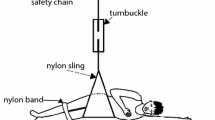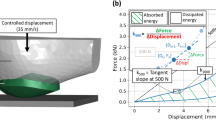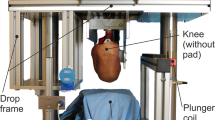Abstract
Summary
Through experiments that simulated sideways falls with a mechanical hip impact simulator, we demonstrated the protective effect of hip abductor muscle forces in reducing peak stresses at the femoral neck and the corresponding risk for hip fracture.
Introduction
Over 90 % of hip fractures are due to falls, and an improved understanding the factors that separate injurious and non-injurious falls (via their influence on the peak stress generated at the femoral neck) may lead to improved risk assessment and prevention strategies. The purpose of this study was to measure the effect of muscle forces spanning the hip, and knee boundary conditions, on peak forces and estimated stresses at the femoral neck during simulated falls with a mechanical system.
Methods
We simulated hip abductor muscle forces and knee boundary conditions with a mechanical hip impact simulator and measured forces and stresses at the femoral neck during sideways falls.
Results
Peak compressive and tensile stresses, shear force, bending moment, and axial force are each associated with hip abductor muscle forces and knee boundary conditions (p < 0.0005). When muscle force increased from 400 to 1,200 N, peak compressive and tensile stresses decreased 24 and 56 %, respectively. These effects were similar to the magnitude of decline in fracture strength associated with osteoporosis and arose from the tension-band effect of the muscle in reducing the bending moment by 37 %. Furthermore, peak compressive and tensile stresses averaged 40 and 51 % lower, respectively, in the free knee than fixed knee condition.
Conclusions
Contraction of the hip abductor muscles at the moment of impact during a fall, and landing with the knee free of constraints, substantially reduced peak compressive and tensile stresses at the femoral neck and risk for femoral fracture in a sideways fall.






Similar content being viewed by others
References
Goeree R, O’Brien B, Pettitt D, Cuddy L, Ferraz M, Adachi JD (1996) An assessment of the burden of illness due to osteoporosis in Canada. J Soc Obstet Gynaecol Can 18:15–24
Empana JP, Dargent-Molina P, Breart G (2004) Effect of hip fracture on mortality in elderly women: the EPIDOS prospective study. J Am Geriatr Soc 52:685–690
Wolinsky FD, Fitzgerald JF, Stump TE (1997) The effect of hip fracture on mortality, hospitalization, and functional status: a prospective study. Am J Public Health 87:398–403
Grisso JA, Schwarz DF, Wishner AR, Weene B, Holmes JH, Sutton RL (1990) Injuries in an elderly inner-city population. J Am Geriatr Soc 38:1326–1331
Tinetti ME, Speechley M, Ginter SF (1988) Risk factors for falls among elderly persons living in the community. N Engl J Med 319:1701–1707
Sattin RW (1992) Falls among older persons: a public health perspective. Annu Rev Public Health 13:489–508
Bouxsein ML, Szulc P, Munoz F, Thrall E, Sornay-Rendu E, Delmas PD (2007) Contribution of trochanteric soft tissues to fall force estimates, the factor of risk, and prediction of hip fracture risk. J Bone Miner Res 22:825–831
Cheng XG, Lowet G, Boonen S, Nicholson PH, Brys P, Nijs J, Dequeker J (1997) Assessment of the strength of proximal femur in vitro: relationship to femoral bone mineral density and femoral geometry. Bone 20:213–218
Manske SL, Liu-Ambrose T, de Bakker PM, Liu D, Kontulainen S, Guy P, Oxland TR, McKay HA (2006) Femoral neck cortical geometry measured with magnetic resonance imaging is associated with proximal femur strength. Osteoporos Int 17:1539–1545
Pulkkinen P, Jamsa T, Lochmuller EM, Kuhn V, Nieminen MT, Eckstein F (2008) Experimental hip fracture load can be predicted from plain radiography by combined analysis of trabecular bone structure and bone geometry. Osteoporos Int 19:547–558
Laing AC, Robinovitch SN (2008) The force attenuation provided by hip protectors depends on impact velocity, pelvic size, and soft tissue stiffness. J Biomech Eng 130:061005
Choi WJ, Hoffer JA, Robinovitch SN (2010) Effect of hip protectors, falling angle and body mass index on pressure distribution over the hip during simulated falls. Clin Biomech (Bristol Avon) 25:63–69
Choi WJ, Robinovitch SN (2011) Pressure distribution over the palm region during forward falls on the outstretched hands. J Biomech 44:532–539
Patriarco AG, Mann RW, Simon SR, Mansour JM (1981) An evaluation of the approaches of optimization models in the prediction of muscle forces during human gait. J Biomech 14:513–525
Ozkaya N, Nordin M (1999) Fundamentals of biomechanics: equilibrium, motion, and deformation. Springer Science, New York
Robinovitch SN, Hayes WC, McMahon TA (1991) Prediction of femoral impact forces in falls on the hip. J Biomech Eng 113:366–374
Robinovitch SN, Feldman F, Yang Y, Schonnop R, Leung PM, Sarraf T, Sims-Gould J, Loughin M (2013) Video capture of the circumstances of falls in elderly people residing in long-term care: an observational study. Lancet 381:47–54
Choi WJ, Hoffer JA, Robinovitch SN (2010) The effect of positioning on the biomechanical performance of soft shell hip protectors. J Biomech 43:818–825
Tortora GJ, Nielsen M (2009) Principles of human anatomy. Wiley
Feldman F, Robinovitch SN (2007) Reducing hip fracture risk during sideways falls: evidence in young adults of the protective effects of impact to the hands and stepping. J Biomech 40:2612–2618
Scheck M (1980) The significance of posterior comminution in femoral neck fractures. Clin Orthop Relat Res: 138–142
Lotz JC, Cheal EJ, Hayes WC (1995) Stress distributions within the proximal femur during gait and falls: implications for osteoporotic fracture. Osteoporos Int 5:252–261
Mayhew PM, Thomas CD, Clement JG, Loveridge N, Beck TJ, Bonfield W, Burgoyne CJ, Reeve J (2005) Relation between age, femoral neck cortical stability, and hip fracture risk. Lancet 366:129–135
Verhulp E, van Rietbergen B, Huiskes R (2008) Load distribution in the healthy and osteoporotic human proximal femur during a fall to the side. Bone 42:30–35
de Bakker PM, Manske SL, Ebacher V, Oxland TR, Cripton PA, Guy P (2009) During sideways falls proximal femur fractures initiate in the superolateral cortex: evidence from high-speed video of simulated fractures. J Biomech 42:1917–1925
Cooper C, Barker DJ, Wickham C (1988) Physical activity, muscle strength, and calcium intake in fracture of the proximal femur in Britain. BMJ 297:1443–1446
Cummings SR, Nevitt MC, Browner WS, Stone K, Fox KM, Ensrud KE, Cauley J, Black D, Vogt TM (1995) Risk factors for hip fracture in white women. Study of Osteoporotic Fractures Research Group. N Engl J Med 332:767–773
Davis JC, Robertson MC, Ashe MC, Liu-Ambrose T, Khan KM, Marra CA (2010) Does a home-based strength and balance programme in people aged > or =80 years provide the best value for money to prevent falls? A systematic review of economic evaluations of falls prevention interventions. Br J Sports Med 44:80–89
Petridou ET, Manti EG, Ntinapogias AG, Negri E, Szczerbinska K (2009) What works better for community-dwelling older people at risk to fall? A meta-analysis of multifactorial versus physical exercise-alone interventions. J Aging Health 21:713–729
Morgan EF, Keaveny TM (2001) Dependence of yield strain of human trabecular bone on anatomic site. J Biomech 34:569–577
Currey JD (2004) Tensile yield in compact bone is determined by strain, post-yield behaviour by mineral content. J Biomech 37:549–556
Haider IT, Speirs AD, Frei H (2013) Effect of boundary conditions, impact loading and hydraulic stiffening on femoral fracture strength. J Biomech 46:2115–2121
Keyak JH, Skinner HB, Fleming JA (2001) Effect of force direction on femoral fracture load for two types of loading conditions. J Orthop Res 19:539–544
Pinilla TP, Boardman KC, Bouxsein ML, Myers ER, Hayes WC (1996) Impact direction from a fall influences the failure load of the proximal femur as much as age-related bone loss. Calcif Tissue Int 58:231–235
Fyhrie DP, Schaffler MB (1994) Failure mechanisms in human vertebral cancellous bone. Bone 15:105–109
Kopperdahl DL, Keaveny TM (1998) Yield strain behavior of trabecular bone. J Biomech 31:601–608
Carter DR, Hayes WC (1977) The compressive behavior of bone as a two-phase porous structure. J Bone Joint Surg Am 59:954–962
McElhaney JH (1966) Dynamic response of bone and muscle tissue. J Appl Physiol 21:1231–1236
Galante J, Rostoker W, Ray RD (1970) Physical properties of trabecular bone. Calcif Tissue Res 5:236–246
Weaver JK, Chalmers J (1966) Cancellous bone: its strength and changes with aging and an evaluation of some methods for measuring its mineral content. J Bone Joint Surg Am 48:289–298
Ebbesen EN, Thomsen JS, Beck-Nielsen H, Nepper-Rasmussen HJ, Mosekilde L (1999) Age- and gender-related differences in vertebral bone mass, density, and strength. J Bone Miner Res 14:1394–1403
Duchemin L, Bousson V, Raossanaly C, Bergot C, Laredo JD, Skalli W, Mitton D (2008) Prediction of mechanical properties of cortical bone by quantitative computed tomography. Med Eng Phys 30:321–328
Lotz JC, Gerhart TN, Hayes WC (1991) Mechanical properties of metaphyseal bone in the proximal femur. J Biomech 24:317–329
Lotz JC, Gerhart TN, Hayes WC (1990) Mechanical properties of trabecular bone from the proximal femur: a quantitative CT study. J Comput Assist Tomogr 14:107–114
Martens M, Van Audekercke R, Delport P, De Meester P, Mulier JC (1983) The mechanical characteristics of cancellous bone at the upper femoral region. J Biomech 16:971–983
Burstein AH, Reilly DT, Martens M (1976) Aging of bone tissue: mechanical properties. J Bone Joint Surg Am 58:82–86
Melick RA, Miller DR (1966) Variations of tensile strength of human cortical bone with age. Clin Sci 30:243–248
Acknowledgments
Funded by grants from the Canadian Institutes for Health Research (CIHR; grant numbers AMG-100487 and TIR-103945) and the Canadian Natural Science and Engineering Research Council (NSERC; grant number RGPIN 239735).
Conflicts of interest
WJC and SNR do not have any financial or personal relationships with other people or organizations that could inappropriately influence this work, including employment, consultancies, stock ownership, honoraria, paid expert testimony, patent applications/registrations, and grants or other funding. Author PAC owns shares in a consulting company that could benefit through his association with this study.
Author information
Authors and Affiliations
Corresponding author
Rights and permissions
About this article
Cite this article
Choi, W.J., Cripton, P.A. & Robinovitch, S.N. Effects of hip abductor muscle forces and knee boundary conditions on femoral neck stresses during simulated falls. Osteoporos Int 26, 291–301 (2015). https://doi.org/10.1007/s00198-014-2812-4
Received:
Accepted:
Published:
Issue Date:
DOI: https://doi.org/10.1007/s00198-014-2812-4




